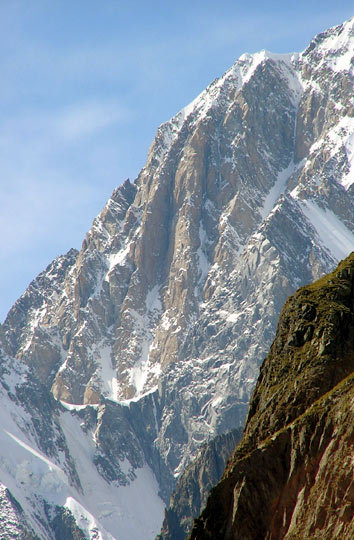
The magnificent Brouillard (left) and Freney faces of Mont Blanc showing the line of the new route Jean-Chri (5.12a A1, 800m, Dumarest-Gabarrou, 2007) on the Hidden Pillar of Freney. [Photo] Antonio Giani
Guru of the Mont Blanc Massif, Patrick Gabarrou has added yet another route to his tally of first ascents on the Freney face of Mont Blanc, creating a second line on the remote and rarely climbed Hidden Pillar. Starting toward the right side of the southeast face, close to the goulotte separating it from the classic Central Pillar, the new line was apparently first conceived, but not attempted, by Gabarrou and the late Jean-Christophe Lafaille. The first opportunity to touch the rock came in mid summer this year, when Gabarrou and Christophe Dumarest reached the start of the difficulities but were soon sent packing by bad weather. They left a sac of gear on a ledge at the base of the rock wall at ca. 4200 meters. Returning at the end of the summer, the pair climbed several pitches up the right side of the wall, traversed left on ledges and breached the headwall (The Red Wall) right of the original American route. Dumarest, who led the hard stuff, climbed free up to 5.12a and then used aid on the more difficult sections high on the wall. He suspects the route could be climbed free by those strong enough to negotiate 5.12d or 13a at over 4400m.
The Freney pillars rise 800 meters from the upper Freney Glacier to the crest of the Brouillard Ridge. The Right Hand Pillar, climbed first in 1940 by Paolo Bollini and the great Giusto Gervasutti is not as well defined as the famous Central Pillar, climbed in 1961 by Chris Bonington, Ian Clough, Jan Duglosz and Don Whillans, or the South Pillar, first climbed in its entirety in 1972 by two great French guides, Louis Dubost and Yannick Seigneur. Both pillars stand proud from the face. The Hidden Pillar, between Central and South, lies flush with the face and only begins half way up it. Reaching the base requires climbing a relatively straightforward but objectively dangerous couloir, often raked by stonefall from the gullies either side of the pillar above. However, even on the 350-meter pillar itself, climbing is far from safe; several of the small number of teams to have made an ascent have reported an alarming amount of rock and ice fall originating from the ledges at the pillar’s top.
Gabarrou and Dumarest left the Eccles bivouac hut on the Innominata Ridge, descended to the upper Freney Glacier and that evening were bivoucked at the top of the pillar having climbed seven long new pitches. The following day they reached the crest of the Brouillard Ridge in a fierce storm, with winds reported to be more than 100 kph. Crawling on hands and knees, each using two axes to avoid being blown into the void, they reached the summit. The route has been named Jean-Chri (5.12a A1, 800m).

The Hidden Pillar of Freney really lives up to its name in this photo of the Freney Face from the northeast. Rising from behind the rocky crest of the Peuterey Ridge, the Central Pillar is the dominant feature in the center of the picture. To its left a less steep pillar/spur with an extremely steep and monolithic right wall is the South Pillar. The Hidden Pillar is… hidden… between the two. The upper skyline is the Brouillard Ridge. [Photo] Luca Signorelli
The first ascent of the Hidden Pillar, which until reaching the headwall took a line of cracks up the left side of the face, was a tour de force by Americans Tom Frost and John Harlin, who climbed it over August 1-2, 1963. Together with Gary Hemming and Stuart Fulton the two Americans had just made the highly coveted first ascent of the south face of the Fou and were now taking part in the international Rassemblement, which in those days took place annually in Chamonix. Frost and Harlin climbed the pillar at VI and A3, creating probably the hardest route to the summit of Mont Blanc. Writing in the American Alpine Journal, Harlin reported, “the excellent quality of the rock, the technical difficulty, the high altitude, and the wild surroundings of the Freney face, combine to make a route of great proportions.”
The second ascent, in 1969 by Slovenians, Belak and Krivic, was completed under very trying conditions. The legendary Italian, Marco Bernardi, made the third ascent, and first solo, in 1981. On what was probably the fourth ascent, British climbers Paddy Gaunt and Mark Miller completed the route from the Trident Hut to the Vallot Hut in a mere fifteen hours. They mostly climbed free at a maximum of 5.10d, using aid on only one 45-meter pitch of the headwall (A1/A2). The line (10 shortish pitches) has been climbed free at around 5.11b, though who did it first is not clear.